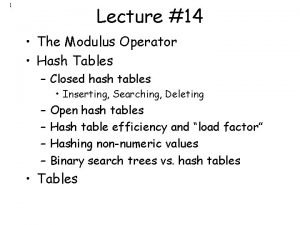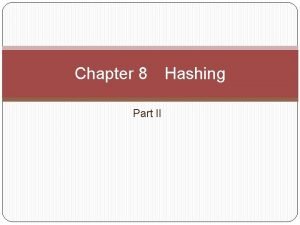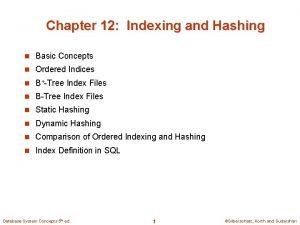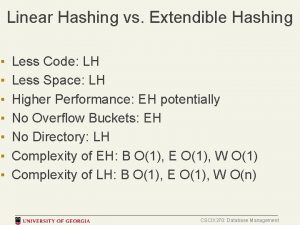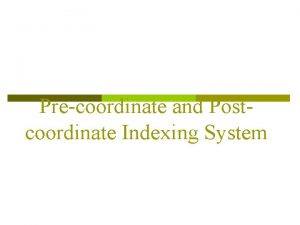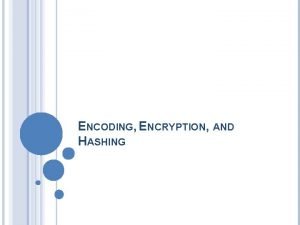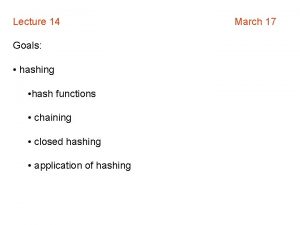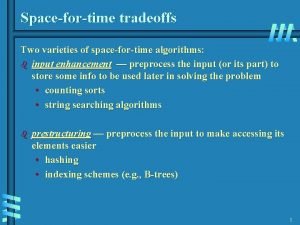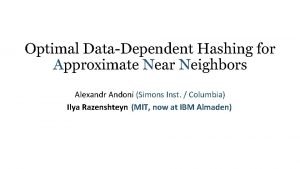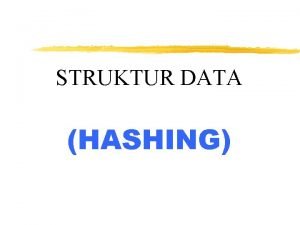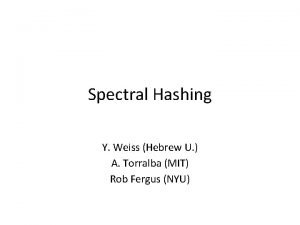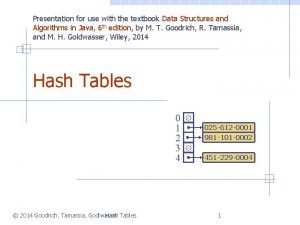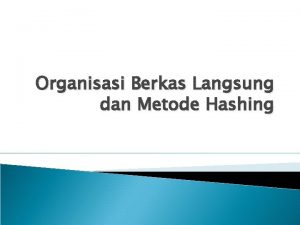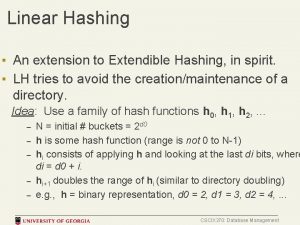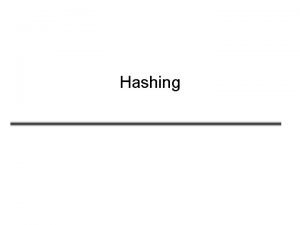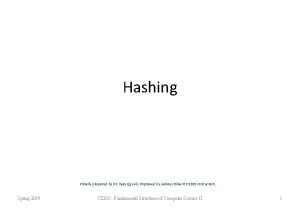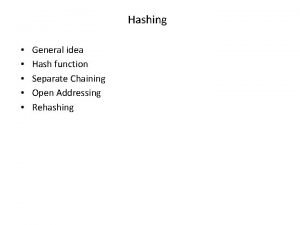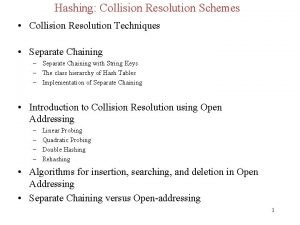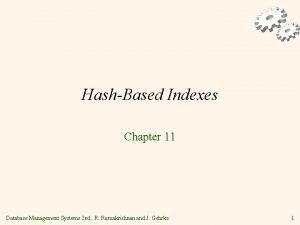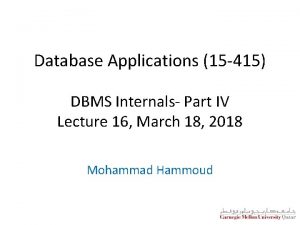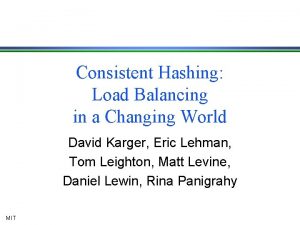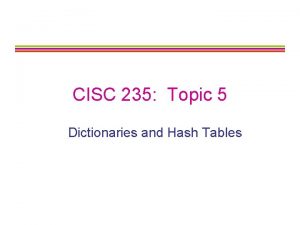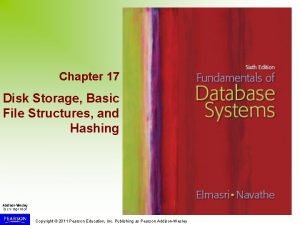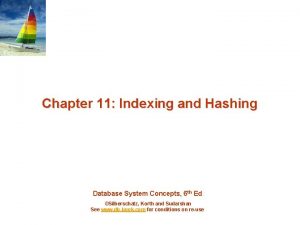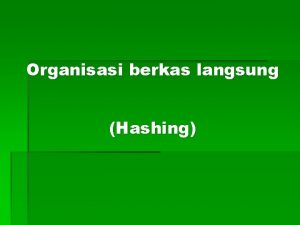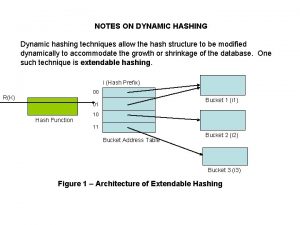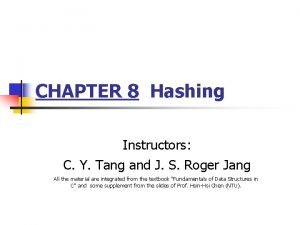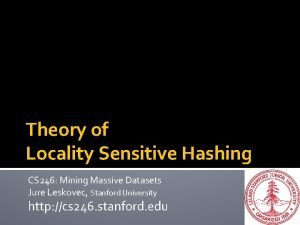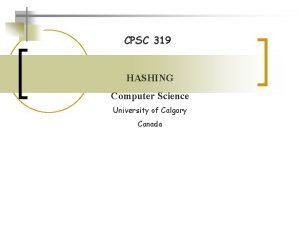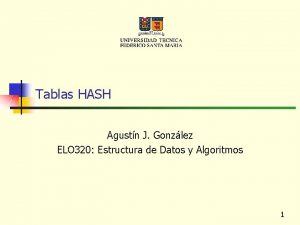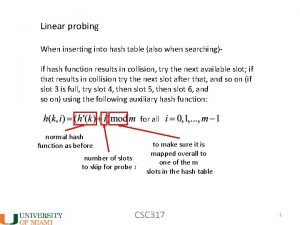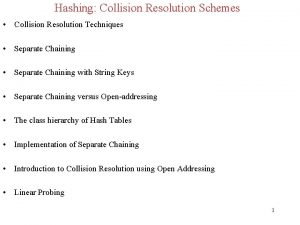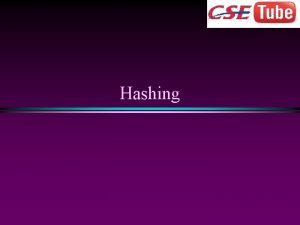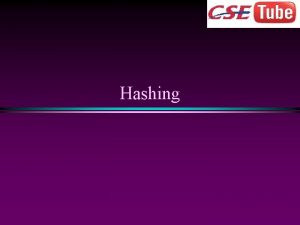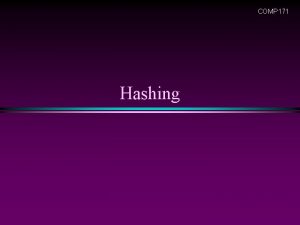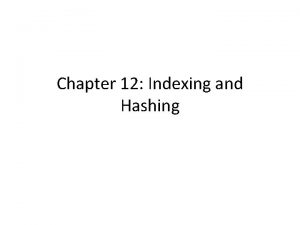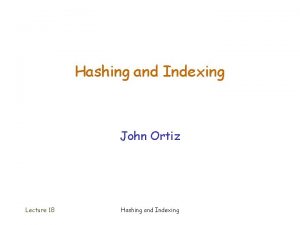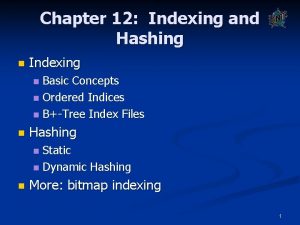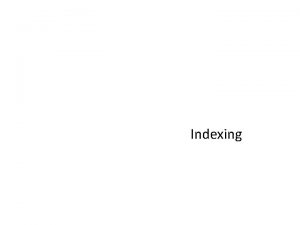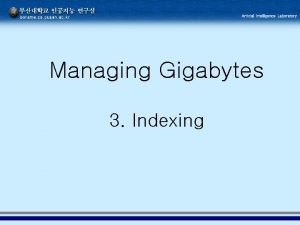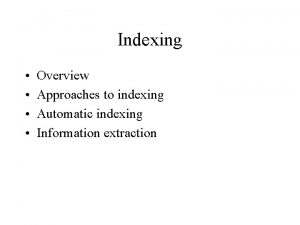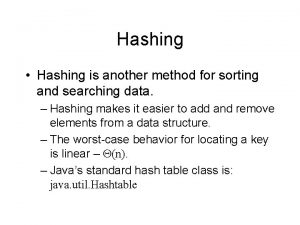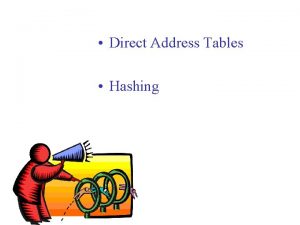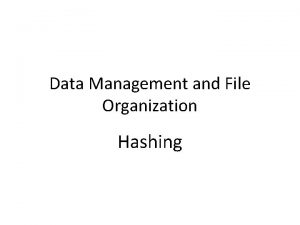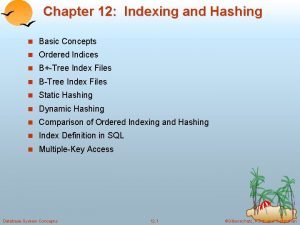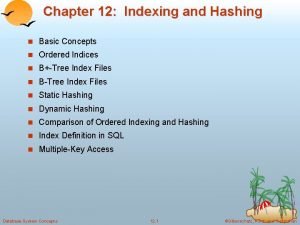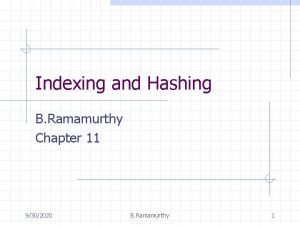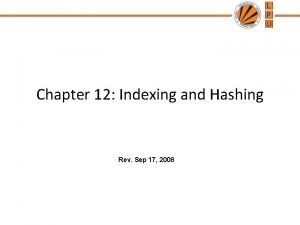Chapter 11 Indexing and Hashing Chapter 12 Indexing















































- Slides: 47

Chapter 11: Indexing and Hashing

Chapter 12: Indexing and Hashing n Basic Concepts n Ordered Indices n B+-Tree Index n Static Hashing n Dynamic Hashing l Briefly n Comparison of Ordered Indexing and Hashing n Index Definition in SQL n Multiple-Key Access

Basic Concepts n Indexing mechanisms used to speed up access to desired data. l E. g. , author catalog in library n Search Key - attribute to set of attributes used to look up records in a file. n An index file consists of records (called index entries) of the form search-key pointer n Index files are typically much smaller than the original file n Two basic kinds of indices: l Ordered indices: search keys are stored in sorted order l Hash indices: search keys are distributed uniformly across “buckets” using a “hash function”.

Index Evaluation Metrics n Access types supported efficiently. l records with a specified value in the attribute, or l records with an attribute value falling in a specified range of values. n Access time n Insertion time n Deletion time n Space overhead

Ordered Indices n In an ordered index, index entries are stored sorted on the search key value. l E. g. , author catalog in library. n Primary index: in a sequentially ordered file, the index whose search key specifies the sequential order of the file. l Also called clustering index to avoid confusion with Primary Key. l The search key of a primary index is usually, but not necessarily, the primary key. n Secondary index: an index whose search key specifies an order different from the sequential order of the file. Also called non-clustering index. n Index-sequential file: ordered sequential file with a primary index.

Dense Index Files n Dense index — Index record appears for every search-key value in the file. n E. g. index on ID attribute of instructor relation

Dense Index Files (Cont. ) n Dense index on dept_name, with instructor file sorted on dept_name

Sparse Index Files n Sparse Index: contains index records for only some search-key values. l Applicable when records are sequentially ordered on search-key n To locate a record with search-key value K we: l Find index record with largest search-key value < K l Search file sequentially starting at the record to which the index record points Ordered by ID

Sparse Index Files (Cont. ) n Compared to dense indices: l Less space and less maintenance overhead for insertions and deletions. l Generally slower than dense index for locating records. n Good tradeoff: sparse index with an index entry for every block in file, corresponding to least search-key value in the block.

Secondary Indices Example Secondary index on salary field of instructor n Index record points to a bucket that contains pointers to all the actual records with that particular search-key value. n Secondary indices have to be dense

Primary and Secondary Indices n Indices offer substantial benefits when searching for records. n BUT: Updating indices imposes overhead on database modification --when a file is modified, every index on the file must be updated, n Sequential scan using primary index is efficient, but a sequential scan using a secondary index is expensive l Each record access may fetch a new block from disk l Block fetch requires about 5 to 10 milliseconds, versus about 100 nanoseconds for memory access

Multilevel Index n If primary index does not fit in memory, access becomes expensive. n Solution: treat primary index kept on disk as a sequential file and construct a sparse index on it. l outer index – a sparse index of primary index l inner index – the primary index file n If even outer index is too large to fit in main memory, yet another level of index can be created, and so on. n Indices at all levels must be updated on insertion or deletion from the file.

Multilevel Index (Cont. )

Index Update: Deletion n If deleted record was the only record in the file with its particular search-key value, the search-key is deleted from the index also. n Single-level index entry deletion: l Dense indices – deletion of search-key is similar to file record deletion. l Sparse indices – 4 If an entry for the search key exists in the index, it is deleted by replacing the entry in the index with the next search-key value in the file (in search-key order). 4 If the next search-key value already has an index entry, the entry is deleted instead of being replaced.

Index Update: Insertion n Single-level index insertion: l Perform a lookup using the search-key value appearing in the record to be inserted. l Dense indices – if the search-key value does not appear in the index, insert it. l Sparse indices – if index stores an entry for each block of the file, no change needs to be made to the index unless a new block is created. 4 If a new block is created, the first search-key value appearing in the new block is inserted into the index. n Multilevel insertion and deletion: algorithms are simple extensions of the single-level algorithms

Secondary Indices n Frequently, one wants to find all the records whose values in a certain field (which is not the searchkey of the primary index) satisfy some condition. l Example 1: In the instructor relation stored sequentially by ID, we may want to find all instructors in a particular department l Example 2: as above, but where we want to find all instructors with a specified salary or with salary in a specified range of values n We can have a secondary index with an index record for each search-key value

B+-Tree Index Files B+-tree indices are an alternative to indexed-sequential files. n Disadvantage of indexed-sequential files performance degrades as file grows, since many overflow blocks get created. l Periodic reorganization of entire file is required. n Advantage of B+-tree index files: l automatically reorganizes itself with small, local, changes, in the face of insertions and deletions. l Reorganization of entire file is not required to maintain performance. n (Minor) disadvantage of B+-trees: l extra insertion and deletion overhead, space overhead. n Advantages of B+-trees outweigh disadvantages l B+-trees are used extensively l

Example of B+-Tree

B+-Tree Index Files (Cont. ) A B+-tree is a rooted tree satisfying the following properties: n All paths from root to leaf are of the same length n Each node that is not a root or a leaf has between n/2 and n children. n A leaf node has between (n– 1)/2 and n– 1 values n Special cases: l If the root is not a leaf, it has at least 2 children. l If the root is a leaf (that is, there are no other nodes in the tree), it can have between 0 and (n– 1) values.

B+-Tree Node Structure n Typical node l Ki are the search-key values l Pi are pointers to children (for non-leaf nodes) or pointers to records or buckets of records (for leaf nodes). n The search-keys in a node are ordered K 1 < K 2 < K 3 <. . . < Kn– 1 (Initially assume no duplicate keys, address duplicates later)

Leaf Nodes in B+-Trees Properties of a leaf node: n For i = 1, 2, . . . , n– 1, pointer Pi points to a file record with search- key value Ki, n If Li, Lj are leaf nodes and i < j, Li’s search-key values are less than or equal to Lj’s search-key values n Pn points to next leaf node in search-key order

Non-Leaf Nodes in B+-Trees n Non leaf nodes form a multi-level sparse index on the leaf nodes. For a non-leaf node with m pointers: l All the search-keys in the subtree to which P 1 points are less than K 1 l For 2 i n – 1, all the search-keys in the subtree to which Pi points have values greater than or equal to Ki– 1 and less than Ki l All the search-keys in the subtree to which Pn points have values greater than or equal to Kn– 1

Example of B+-tree for instructor file (n = 6) n Leaf nodes must have between 3 and 5 values ( (n– 1)/2 and n – 1, with n = 6). n Non-leaf nodes other than root must have between 3 and 6 children ( (n/2 and n with n =6). n Root must have at least 2 children.

Observations about B+-trees n Since the inter-node connections are done by pointers, “logically” close blocks need not be “physically” close. n The non-leaf levels of the B+-tree form a hierarchy of sparse indices. n The B+-tree contains a relatively small number of levels 4 Level 4 Next 4. . below root has at least 2* n/2 values level has at least 2* n/2 values etc. l If there are K search-key values in the file, the tree height is no more than log n/2 (K) l thus searches can be conducted efficiently. n Insertions and deletions to the main file can be handled efficiently, as the index can be restructured in logarithmic time.

Queries on B+-Trees n Find record with search-key value V. 1. 2. 3. 4. 5. C=root While C is not a leaf node { 1. Let i be least value s. t. V Ki. 2. If no such exists, set C = last non-null pointer in C 3. Else { if (V= Ki ) Set C = Pi +1 else set C = Pi} } Let i be least value s. t. Ki = V If there is such a value i, follow pointer Pi to the desired record. Else no record with search-key value k exists.

Queries on B+-Trees (Cont. ) n If there are K search-key values in the file, the height of the tree is no more than log n/2 (K). n A node is generally the same size as a disk block, typically 4 kilobytes l and n is typically around 100 (40 bytes per index entry). n With 1 million search key values and n = 100 l at most log 50(1, 000) = 4 nodes are accessed in a lookup. n Contrast this with a balanced binary tree with 1 million search key values — around 20 nodes are accessed in a lookup l above difference is significant since every node access may need a disk I/O, costing around 20 milliseconds

Multiple-Key Access n Use multiple indices for certain types of queries. n Example: select ID from instructor where dept_name = “Finance” and salary = 80000 n Possible strategies for processing query using indices on single attributes: 1. Use index on dept_name to find instructors with department name Finance; test salary = 80000 2. Use index on salary to find instructors with a salary of $80000; test dept_name = “Finance”. 3. Use dept_name index to find pointers to all records pertaining to the “Finance” department. Similarly use index on salary. Take intersection of both sets of pointers obtained.

Indices on Multiple Keys n Composite search keys are search keys containing more than one attribute l E. g. (dept_name, salary) n Lexicographic ordering: (a 1, a 2) < (b 1, b 2) if either l a 1 < b 1, or l a 1=b 1 and a 2 < b 2

Indices on Multiple Attributes Suppose we have an index on combined search-key (dept_name, salary). n With the where clause where dept_name = “Finance” and salary = 80000 the index on (dept_name, salary) can be used to fetch only records that satisfy both conditions. l Using separate indices is less efficient — we may fetch many records (or pointers) that satisfy only one of the conditions. n Can also efficiently handle where dept_name = “Finance” and salary < 80000 n But cannot efficiently handle where dept_name < “Finance” and balance = 80000 l May fetch many records that satisfy the first but not the secondition l The order of the attributes matter!

Hashing

Static Hashing n A bucket is a unit of storage containing one or more records (a bucket is typically a disk block). n In a hash file organization we obtain the bucket of a record directly from its search-key value using a hash function. n Hash function h is a function from the set of all search-key values K to the set of all bucket addresses B. n Hash function is used to locate records for access, insertion as well as deletion. n Records with different search-key values may be mapped to the same bucket; bucket thus entire bucket has to be searched sequentially to locate a record.

Example of Hash File Organization Hash file organization of instructor file, using dept_name as key (See figure in next slide. ) n There are 10 buckets, n The binary representation of the ith character is assumed to be the integer i. n The hash function returns the sum of the binary representations of the characters modulo 10 l E. g. h(Music) = 1 h(History) = 2 h(Physics) = 3 h(Elec. Eng. ) = 3

Example of Hash File Organization Hash file organization of instructor file, using dept_name as key (see previous slide for details).

Hash Functions n Worst hash function maps all search-key values to the same bucket; l The access is time proportional to the number of search-key values in the file. n An ideal hash function is uniform, i. e. , each bucket is assigned the same number of search-key values from the set of all possible values. n Ideal hash function is random, so each bucket will have the same number of records assigned to it irrespective of the actual distribution of search-key values in the file. n Typical hash functions perform computation on the internal binary representation of the search-key. l For example, for a string search-key, the binary representations of all the characters in the string could be added and the sum modulo the number of buckets could be returned.

Handling of Bucket Overflows n Bucket overflow can occur because of l Insufficient buckets l Skew in distribution of records. This can occur due to two reasons: 4 multiple records have same search-key value 4 chosen hash function produces non-uniform distribution of key values n Although the probability of bucket overflow can be reduced, it cannot be eliminated; it is handled by using overflow buckets.

Handling of Bucket Overflows (Cont. ) n Overflow chaining – the overflow buckets of a given bucket are chained together in a linked list. n Above scheme is called closed hashing. l An alternative, called open hashing, which does not use overflow buckets, is not suitable for database applications.

Hash Indices n Hashing can be used not only for file organization, but also for index-structure creation. n A hash index organizes the search keys, with their associated record pointers, into a hash file structure. n Strictly speaking, hash indices are always secondary indices l if the file itself is organized using hashing, a separate primary hash index on it using the same search-key is unnecessary. l However, we use the term hash index to refer to both secondary index structures and hash organized files.

Example of Hash Index hash index on instructor, on attribute ID

Deficiencies of Static Hashing n In static hashing, function h maps search-key values to a fixed set of B of bucket addresses. Databases grow or shrink with time. l If initial number of buckets is too small, and file grows, performance will degrade due to too much overflows. l If space is allocated for anticipated growth, a significant amount of space will be wasted initially (and buckets will be underfull). l If database shrinks, again space will be wasted. n One solution: periodic re-organization of the file with a new hash function l Expensive, disrupts normal operations n Better solution: allow the number of buckets to be modified dynamically.

Dynamic Hashing n Good for database that grows and shrinks in size n Allows the hash function to be modified dynamically

Comparison of Ordered Indexing and Hashing n Cost of periodic re-organization n Relative frequency of insertions and deletions n Is it desirable to optimize average access time at the expense of worst-case access time? n Expected type of queries: l Hashing is generally better at retrieving records having a specified value of the key. l If range queries are common, ordered indices are to be preferred n In practice: l Postgre. SQL supports hash indices, but discourages use due to poor performance l Oracle supports static hash organization, but not hash indices l SQLServer supports only B+-trees

Bitmap Indices n Bitmap indices are a special type of index designed for efficient querying on multiple keys n Records in a relation are assumed to be numbered sequentially from, say, 0 l Given a number n it must be easy to retrieve record n 4 Particularly easy if records are of fixed size n Applicable on attributes that take on a relatively small number of distinct values l E. g. gender, country, state, … l E. g. income-level (income broken up into a small number of levels such as 0 -9999, 10000 -19999, 20000 -50000, 50000 infinity) n A bitmap is simply an array of bits

Bitmap Indices (Cont. ) n In its simplest form a bitmap index on an attribute has a bitmap for each value of the attribute l Bitmap has as many bits as records l In a bitmap for value v, the bit for a record is 1 if the record has the value v for the attribute, and is 0 otherwise

Bitmap Indices (Cont. ) n Bitmap indices are useful for queries on multiple attributes l n n not particularly useful for single attribute queries Queries are answered using bitmap operations l Intersection (and) l Union (or) l Complementation (not) Each operation takes two bitmaps of the same size and applies the operation on corresponding bits to get the result bitmap l E. g. 100110 AND 110011 = 100010 100110 OR 110011 = 110111 NOT 100110 = 011001 l Males with income level L 1: 10010 AND 10100 = 10000 4 Can then retrieve required tuples. 4 Counting number of matching tuples is even faster

Bitmap Indices (Cont. ) n Bitmap indices generally are very small compared with relation size l E. g. if record is 100 bytes, space for a single bitmap is 1/800 of space used by relation. 4 If the number of distinct attribute values is 8, bitmap is only 1% of relation size

Index Definition in SQL n Create an index create index <index-name> on <relation-name> (<attribute-list>) E. g. : create index b-index on branch(branch_name) n Use create unique index to indirectly specify and enforce the condition that the search key is a candidate key. l Not really required if SQL unique integrity constraint is supported n To drop an index drop index <index-name> n Most database systems allow specification of type of index, and clustering.

End of Chapter
 What does a modulo operator do
What does a modulo operator do Motivation for dynamic hashing
Motivation for dynamic hashing Static and dynamic hashing in dbms
Static and dynamic hashing in dbms Extendible hashing vs linear hashing
Extendible hashing vs linear hashing Post coordinate indexing system
Post coordinate indexing system Contoh pengindeksan manual
Contoh pengindeksan manual Encoding encryption and hashing
Encoding encryption and hashing Probability theory in hashing and load balancing
Probability theory in hashing and load balancing טבלת גיבוב
טבלת גיבוב Closed hashing
Closed hashing Password hashing and preprocessing
Password hashing and preprocessing Password hashing and preprocessing
Password hashing and preprocessing Bagaimana mencari data hashing dengan kunci modulus n?
Bagaimana mencari data hashing dengan kunci modulus n? Static hashing
Static hashing Hashing
Hashing Double hashing
Double hashing Organisasi berkas langsung
Organisasi berkas langsung Linear hashing example
Linear hashing example Hash multiplication method
Hash multiplication method Mid-square hashing
Mid-square hashing Quadratic probing
Quadratic probing Double hashing example
Double hashing example Hashing exercises
Hashing exercises Hashing collision resolution
Hashing collision resolution Double hashing vs linear probing
Double hashing vs linear probing What is static hashing in dbms
What is static hashing in dbms Cmpt 225
Cmpt 225 Double hashing
Double hashing Hashing pergeseran adalah
Hashing pergeseran adalah Dynamic perfect
Dynamic perfect What is static hashing in dbms
What is static hashing in dbms Consistent hashing load balancing
Consistent hashing load balancing Double hashing vs linear probing
Double hashing vs linear probing Internal hashing techniques in dbms
Internal hashing techniques in dbms Hashing in dbms
Hashing in dbms Quadratisches sondieren
Quadratisches sondieren Theoretical evaluation of overflow techniques
Theoretical evaluation of overflow techniques Pengertian organisasi berkas langsung
Pengertian organisasi berkas langsung Dynamic hashing allows us to
Dynamic hashing allows us to What is direct addressing in hashing
What is direct addressing in hashing Load density in hashing
Load density in hashing Cs246 stanford
Cs246 stanford Hashing computer science
Hashing computer science Hashing cerrado
Hashing cerrado Hashing cerrado
Hashing cerrado Linear probing
Linear probing Collision resolution techniques in hashing
Collision resolution techniques in hashing Aka hashing
Aka hashing
